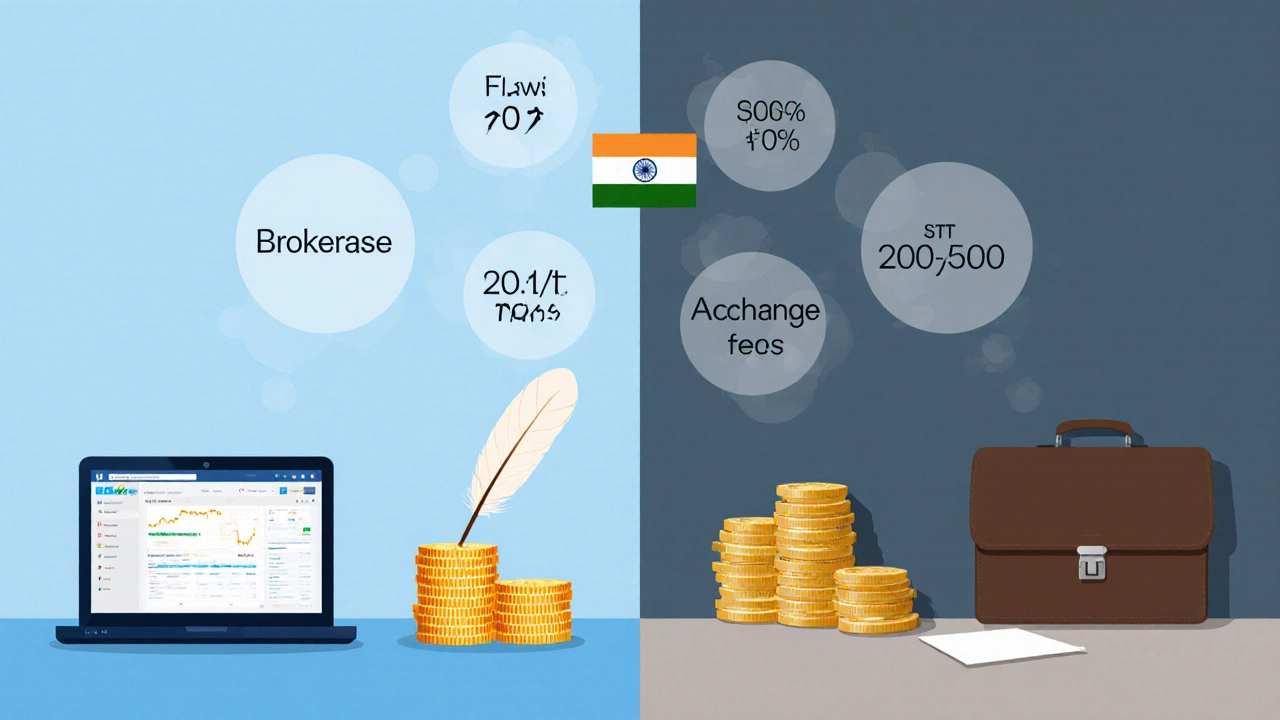Trading Capital Calculator for India
Calculate Your Trading Capital Requirements
Enter your details above to see your capital requirements
Thinking about jumping into the Indian stock market but unsure how much cash you actually need? You’re not alone. Many beginners assume you need a huge lump sum, while others think you can get started with just a few hundred rupees. This guide breaks down every cost, from opening a start trading in India account to the ongoing fees that will affect your profit margin. By the end, you’ll know exactly how much money to set aside and which expenses you can trim.
Quick Takeaways
- Opening a Demat and trading account typically costs between ₹500-₹1,500 one‑time.
- Most discount brokers charge 0.01%-0.05% per trade, with a minimum of ₹20‑₹30.
- For a diversified equity portfolio, aim for at least ₹10,000‑₹15,000 of investable capital.
- If you want to trade derivatives, reserve an extra ₹5,000‑₹10,000 for margin requirements.
- Always keep a safety net of 20%‑30% of your total capital for emergencies and risk management.
What Is Stock Trading in India?
Stock Trading in India is the process of buying and selling shares of publicly listed companies on Indian exchanges such as the National Stock Exchange (NSE) and the Bombay Stock Exchange (BSE). Traders use a Demat (dematerialised) account to hold securities electronically and a brokerage account to place orders. The Securities and Exchange Board of India (SEBI) regulates all market activities, ensuring transparency and investor protection.
Breaking Down the Costs
Expenses fall into three buckets: one‑time setup fees, recurring transaction costs, and capital tied up for positions or margin.
1. One‑Time Setup Fees
- Demat account opening: Most brokers waive the fee, but some charge ₹500‑₹1,000 for account creation and verification.
- Trading account activation: Usually free, though a few legacy full‑service brokers may ask for a ₹2,000‑₹5,000 initiation fee.
- KYC (Know Your Customer) documentation: Proof of identity and address can be verified online at no cost, but courier fees for physical copies can add ₹200‑₹300.
2. Recurring Transaction Costs
- Brokerage per trade: Discount brokers like Zerodha charge 0.01% of the trade value, with a minimum of ₹20. Full‑service brokers may charge 0.5%‑1%.
- STT (Securities Transaction Tax): 0.1% on equity delivery trades, 0.025% on intraday trades.
- Exchange fees: NSE charges 0.00345% of turnover; BSE charges 0.0035%.
- GST: 18% on brokerage and exchange fees.
3. Capital Required for Positions
How much you allocate to actual buying depends on your strategy:
- Equity delivery (buy‑and‑hold): Minimum lot size varies by stock, but you can start with as little as ₹500‑₹1,000 per company if you pick low‑price shares.
- Intraday trading: Requires margin, typically 20%‑30% of the total position size. For a ₹50,000 intraday trade, you need roughly ₹10,000‑₹15,000 as margin.
- Futures & Options (F&O): Higher margin, often 10%‑15% of contract value for futures and up to 20% for options.

Choosing the Right Broker
The broker you pick can dramatically affect your out‑of‑pocket cost. Below is a quick comparison of popular discount and full‑service options as of October 2025.
| Feature | Discount Broker (e.g., Zerodha) | Full‑Service Broker (e.g., ICICI Direct) |
|---|---|---|
| Brokerage per trade | 0.01% (min ₹20) | 0.5%‑1% (min ₹200) |
| Account opening fee | ₹0‑₹500 | ₹2,000‑₹5,000 |
| Research & advisory | Basic charts, free webinars | Analyst reports, portfolio reviews |
| Mobile app rating (Play Store) | 4.6/5 | 4.2/5 |
| Best for | Cost‑conscious beginners & active traders | Investors who need in‑depth advice |
How Different Strategies Influence Capital Needs
Choosing a trading style determines how much you must set aside.
Buy‑and‑Hold (Long‑Term Investing)
You buy shares and keep them for months or years. The main cost is the purchase price plus a tiny brokerage fee. A solid starting portfolio of three diversified stocks can be built with ₹10,000‑₹12,000.
Systematic Investment Plan (SIP) in Mutual Funds
While not direct stock trading, SIPs let you enter the market with as little as ₹500 per month. Over a year, you will have contributed ₹6,000, plus negligible transaction costs.
Intraday Trading
Short‑term buying and selling within the same day requires margin and rapid order execution. To keep risk manageable, many traders limit their capital to ₹20,000‑₹30,000, with only 10%‑15% used for any single trade.
Futures & Options
Derivatives let you control larger positions with less cash, but margin calls can hit hard. A prudent start is ₹25,000‑₹35,000, reserving at least ₹10,000 as a cushion for adverse moves.
Risk Management: The Money You Should Never Touch
Never gamble the whole amount on a single trade. Most seasoned traders keep a “risk buffer” equal to 20%‑30% of total capital. If you start with ₹30,000, set aside ₹6,000‑₹9,000 in a separate savings account. This buffer protects you from margin calls and lets you stay in the market during a losing streak.

Step‑by‑Step Checklist to Start Trading
- Complete KYC: Upload PAN, Aadhaar, and bank details on the broker’s portal.
- Open a Demat and trading account: Most discount brokers approve within 24‑48 hours.
- Fund your account: Transfer the amount you plan to invest (minimum ₹10,000 is a comfortable baseline).
- Set up two‑factor authentication (2FA) and a strong password.
- Choose your first stocks or ETFs: Look for companies with market cap >₹5 billion and average daily volume >1 million shares.
- Place a delivery order: Select “Buy”, enter quantity, and confirm. Pay the brokerage (~₹20) and STT (0.1%).
- Record the trade in a simple spreadsheet: Date, ticker, entry price, position size, and stop‑loss level.
- Monitor daily: Use the broker’s mobile app to track price movement and adjust stop‑loss as needed.
- Review after one month: Evaluate profit/loss, refine your stock selection criteria.
Common Pitfalls and How to Avoid Them
- Under‑estimating fees: Small trades can be eaten by brokerage and taxes. Combine orders or use a discount broker to keep costs low.
- Over‑leveraging: Using too much margin amplifies losses. Stick to a 10%‑15% margin exposure per trade.
- Chasing hot tips: Social media hype often leads to impulse buys. Rely on fundamental analysis or reputable research.
- Ignoring risk buffer: When a trade goes wrong, the buffer prevents a forced liquidate.
- Skipping a trading journal: Without records you can’t learn from mistakes.
Frequently Asked Questions
What is the minimum amount required to open a Demat account?
Most discount brokers charge ₹0‑₹500 as a one‑time fee. Some full‑service houses may ask for up to ₹5,000, but the market is moving toward free Demat accounts.
Can I start trading with less than ₹1,000?
Technically yes, if you pick a low‑priced stock and use a broker with zero account fees. However, such a small amount limits diversification and makes transaction costs proportionally higher, so ₹5,000‑₹10,000 is a more realistic starter sum.
How much should I allocate for emergency cash?
Keep 20%‑30% of your total capital in a liquid savings account. This buffer protects you from margin calls and lets you stay calm during market dips.
Do I need a separate bank account for trading?
No, most brokers link directly to your existing savings or current account for fund transfers. Some traders prefer a dedicated account to track trading cash separately.
What are the tax implications of short‑term gains?
Short‑term capital gains (held < 12 months) are taxed at your personal income tax slab, which can be 10%‑30% plus applicable cess. Long‑term gains on equities (held >12 months) attract a flat 10% tax after a ₹1 lac exemption.
Armed with a clear picture of the costs and a solid plan, you can step into the Indian market with confidence. Remember, the money you start with is just the seed-discipline, research, and risk control are what turn that seed into a thriving portfolio.





Write a comment